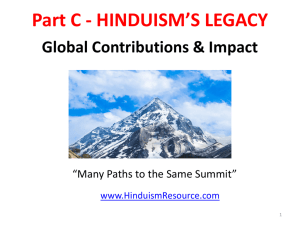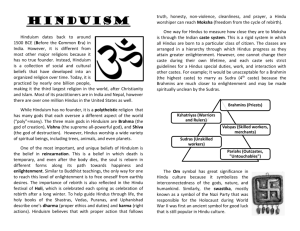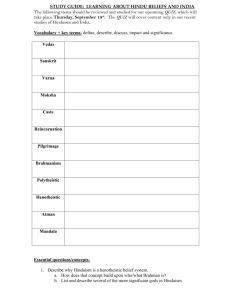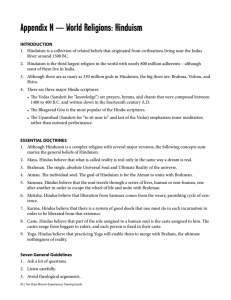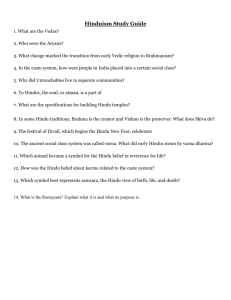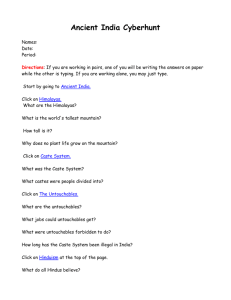Teacher's Guide
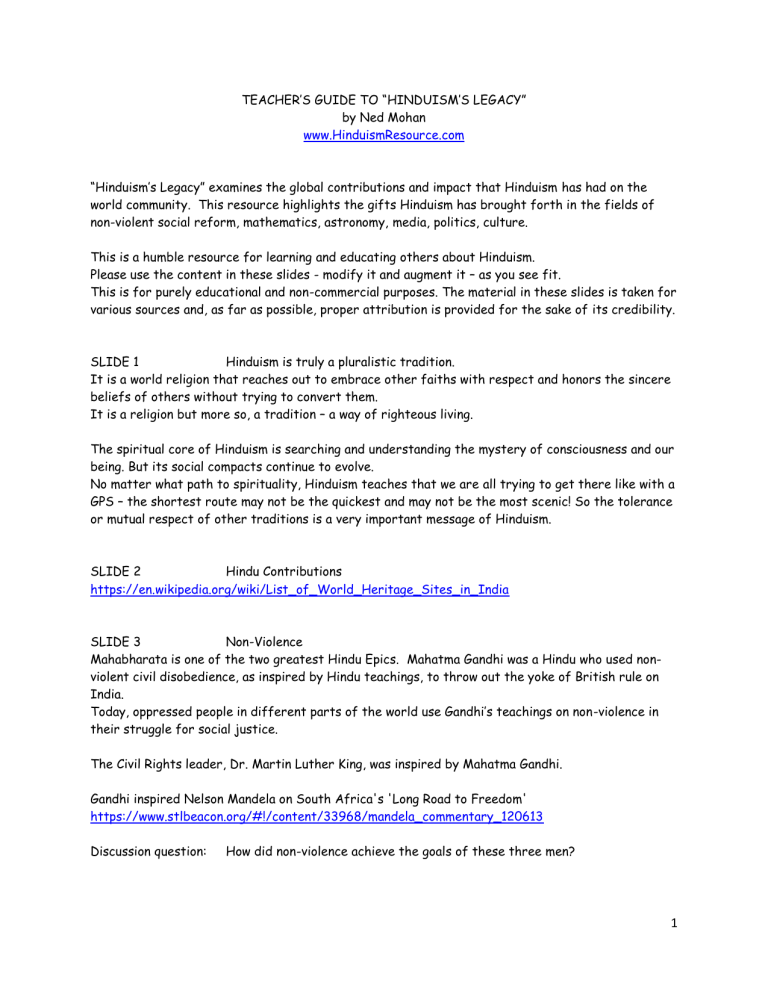
TEACHER’S GUIDE TO “HINDUISM’S LEGACY” by Ned Mohan www.HinduismResource.com
“Hinduism’s Legacy” examines the global contributions and impact that Hinduism has had on the world community. This resource highlights the gifts Hinduism has brought forth in the fields of non-violent social reform, mathematics, astronomy, media, politics, culture.
This is a humble resource for learning and educating others about Hinduism.
Please use the content in these slides - modify it and augment it – as you see fit.
This is for purely educational and non-commercial purposes. The material in these slides is taken for various sources and, as far as possible, proper attribution is provided for the sake of its credibility.
SLIDE 1 Hinduism is truly a pluralistic tradition.
It is a world religion that reaches out to embrace other faiths with respect and honors the sincere beliefs of others without trying to convert them.
It is a religion but more so, a tradition – a way of righteous living.
The spiritual core of Hinduism is searching and understanding the mystery of consciousness and our being. But its social compacts continue to evolve.
No matter what path to spirituality, Hinduism teaches that we are all trying to get there like with a
GPS – the shortest route may not be the quickest and may not be the most scenic! So the tolerance or mutual respect of other traditions is a very important message of Hinduism.
SLIDE 2 Hindu Contributions https://en.wikipedia.org/wiki/List_of_World_Heritage_Sites_in_India
SLIDE 3 Non-Violence
Mahabharata is one of the two greatest Hindu Epics. Mahatma Gandhi was a Hindu who used nonviolent civil disobedience, as inspired by Hindu teachings, to throw out the yoke of British rule on
India.
Today, oppressed people in different parts of the world use Gandhi’s teachings on non-violence in their struggle for social justice.
The Civil Rights leader, Dr. Martin Luther King, was inspired by Mahatma Gandhi.
Gandhi inspired Nelson Mandela on South Africa's 'Long Road to Freedom' https://www.stlbeacon.org/#!/content/33968/mandela_commentary_120613
Discussion question: How did non-violence achieve the goals of these three men?
1
SLIDE 4 Gandhi ji
Gandhi ji (“ji” signifies respect) has inspired many service organizations all over the world.
“In an age in which violence and peace faced each other more fatefully than ever before, Gandhi's name became, in the middle of our century, the counterpoise to those of Stalin and Hitler.
The achievement for which the world credited this man (who weighed less than a hundred pounds and whose worldly possessions when he died were worth less than two dollars) was the British withdrawal from India in peace.... And he renamed India's untouchables (shudras) ‘God's people’
(harijan)... Gandhi's own inspiration and strategy are summarized in his autobiography: `Such power as I possess for working in the political field has derived from my experiments in the spiritual field.
In the spiritual field, truth is the sovereign principle, and the Bhagavad-Gita (described under
Scriptures) is the book par excellence for the knowledge of Truth.” Source: Huston Smith
Photograph by Rena Effendi; National Geographic http://ngm.nationalgeographic.com/2015/07/gandhi/img/07-midwife-tends-pregnant-woman-
580v.jpg
SLIDE 5 Grounds for other Faiths
Most of the followers of Jainism and Sikhism live in India.
Jainism goes back to nearly 950 years before Christ. There are many followers of Jainism in India and there are many common beliefs with Hinduism such a dharma, karma, reincarnation and moksha/nirvana.
Siddharth Gautama, born in a Hindu king family nearly 600 years before Christ, received enlightenment after meditating under a tree for 19 years in northeastern India and became a
Buddha. He led reforms, such as elimination of animal sacrifices in temples, that were being misinterpreted in Hinduism and those practices have disappeared. Therefore, Hindus consider
Buddha as a Reformer and the ninth avatar of Vishnu.
Hindu Kings like Asoka, who have converted to Buddhism, sent missionaries to Southeast Asia to spread Buddhism. To China, Korea and Japan, Buddhism spread as shown in the next slide.
Sikhism spread through Southeast Asia. Most Sikhs live in the Indian state of Punjab.
Research Question: Research one of the spiritual traditions and Hinduism.
How are they similar? How do they differ?
SLIDE 6 Buddha - born in a Hindu king family nearly 600 years before Christ
Led reforms, such as elimination of animal sacrifices in temples
A non-theist: never denied God nor acknowledged God
His message: “I do not care to know your various theories about God.
Do good and be good, and this will take you to freedom and whatever truth there is.”
2
SLIDE 7 No Room for Arrogance
No one has had breakfast with the Infinite face-to-face! - No Hindu should be arrogant!
Carl Sagan - You Are Here (Pale Blue Dot) https://www.youtube.com/watch?v=4PN5JJDh78I
SLIDE 8 Ecology - Sri Bhudevi
Hindus worship mother earth as a Goddess – Sri Bhudevi. Many Hinds believe that getting out of bed in the morning, they are by necessity putting their foot on the chest of their own mother.
Many touch the ground with their forehead as a sign of respect, as one might see the Pope do when he lands in a foreign country.
Similarly a Hindu would never put his/her foot on anything printed. Everything printed symbolizes to Hindus knowledge and if they accidentally touch it with their foot, they touch it with their hand and then to their forehead.
SLIDE 9 Mathematical Contributions http://www.slideshare.net/jaihind/hindu-contribution-to-mathematics-science-archna-sahni
SLIDE 10 Magical Square!
It’s the oldest such four-by-four square although there are earlier three-by-three squares from
China and Persia. Perhaps ancient Hindus and Jains thought that numbers held great powers that they hoped to harness. Source: Why Science Does Not Disprove God - by Amir Aczel
SLIDE 11 Astronomy
More than 1,000 years before Copernicus and Galileo, Aryabhata discovered that the earth revolves around the sun!
SLIDE 12 Medicine
Ayurveda (Sanskrit: Āyurveda, "life-knowledge") or Ayurvedic medicine is a system of traditional
Hindu medicine native to the Indian subcontinent. Contemporary practices derived from Ayurvedic traditions are a type of alternative medicine. Ayurveda is a discipline of the upaveda or "auxiliary knowledge" in Vedic tradition. The origins of Ayurveda are also found in the Atharvaveda, which contains 114 hymns and incantations described as magical cures for disease. Ayurvedic practices include the use of herbal medicines, mineral or metal supplementation, surgical techniques, application of oil by massages, etc. Source: adapted from http://en.wikipedia.org/wiki/Ayurveda
SLIDE 13 Chakras
In the Hindu tradition, our body consists of 7 chakras, like a disc, where several nadis or channels come together.
3
SLIDE 14 Respect for Wisdom
Sri Saraswati is the Godess of knowledge and Wisdom. The instrument you see in her hand is called
Veena –the original instrument of India. It has a very deep sound.
SLIDE 15 Teachers
When human beings come back, Hindus call it reincarnation. When God comes back in a human form occasionally, to teach us all a lesson, Hindus call it avatar. In keeping with the Varna System, the three of the greatest teachers in Hinduism, were not from the Teacher (called Brahmin) class.
Avatars of Vishnu: Sri Ram is the seventh avatar, Sri Krishna is the eight avatar and Lord Buddha, considered a reformer, the ninth avatar.
Sri Ram is a very important deity to all Hindus. Ram they consider the seventh avatar of Lord
Vishnu. Ram means a source of infinite pleasure! We are all looking for it! Whenever they hear the word “Ram”, a sense of calm and absolute peace, absolute serenity, comes over them. Ram also signifies the triumph of good over evil.
His wife Sita was abducted – one may ask how God’s wife can be abducted? Well when God in a human form is here on earth, they are subject to all human conditions – after all they are here to teach us a lesson – like an allegory of journeys that all souls must make. Anyway, his wife was abducted and his heart was broken. He had a disciple, Hanuman, the monkey king who had a monkey army. Sri Hanuman helped Sri Ram rescue his wife who was abducted. Sri Ram was everything that’s good and noble – an ideal son, an ideal brother, an ideal husband and an ideal ruler. All Hindus celebrate Sri Ram’s birthday in a grand style.
Sri Krishna is another very important deity to all Hindus, considered as the eighth avatar of Lord
Vishnu. Sri Krishna is the one who gave a discourse, Bhagavad-Gita, that is one of the most sacred scriptures in Hinduism.
Lord Buddha: born as Siddharth Gautama
- born in a Hindu king family nearly 600 years before Christ
Led reforms, such as elimination of animal sacrifices in temples
A non-theist: never denied God nor acknowledged God
His message: “I do not care to know your various theories about God. Do good and be good, and this will take you to freedom and whatever truth there is.”
Discussion Question: What are the implications of the fact that these three teachers did not come from the Teacher’s class?
SLIDE 16 Prime Minister of India
Being an evolving religion, the modern Hindu society has recognized the irrelevance of the caste system discussed in the previous slide, and actively discourages any form of discrimination based on caste, and it has been made illegal in India after its Independence in 1947.
4
As an example, the present Prime Minister of India, Narendra Modi, elected by an overwhelming majority, comes from a Hindu sub-caste. Kumari Mayavati, from a very low caste, was elected as the
Chief Minister of the largest state in India (Uttar Pradesh) that, if it were to be a country, will be the fifth largest in the world after China, the rest of India, the United States, and Russia!
SLIDE 17 World Heritage Sties
Research Question: Research one of India’s World Heritage Sites.
SLIDE 18 Modern India
10 July 2015 - An Indian rocket has put five UK satellites in orbit.
It is thought to be the largest number of wholly British-built spacecraft to go up on a single launch.
The quintet includes three satellites to image the Earth and support disaster monitoring and relief, and two to test technologies that could be used on future spacecraft. The Indian space agency's
PSLV rocket lifted off from Sriharikota at 21:58 local time (17:28 BST). http://www.bbc.com/news/world-asia-india-33473694.
India’s Mars Mission:
India's space program succeeded at the first attempt where others have failed - by sending an operational mission to Mars.
It is the cheapest. Cost around $70m, gravity(movie) had budget of around $100m.
India is the forth country to reach mars after USSR, USA and European Union.
India is the first country to complete mission in first attempt.
All the technology and resources used in the mission used were all in house, no aid was taken from foreign country. Big achievement.
Probe has a methane detector.
SLIDE 19 Hindu Practices in Larger American Culture
Hindu and other traditions like Christianity have many similarities. One example is “OM”.
Hindu mantras often begin or end with OM, the sonic form of Brahman. It is not a sectarian sound – indeed, Hindus hear this sacred syllable in Judeo-Christen “Amen” and Muslim “Amin.”
Another example is Sri Krishna, the God incarnate to Hindus and what Lord Jesus Christ said:
“Be in the world but not of the world.” Both also are quoted as saying, “He who perceives Me everywhere and beholds everything in Me, never loses sight of Me, nor do I ever lose sight of him”.
The over 2.5 million Hindus living in America have impacted and contributed - thousands of yoga studios, meditation centers, vegetarian restaurants, Ayurvedic health spas, like Aveda.
Millions of Americans believe in reincarnation. Increasingly, more Americans are choosing to be cremated, similar to Hindus, however not due to the influence of Hinduism.
Discussion Question: What are the ecological, communal, and spiritual ramifications of cremation?
5
